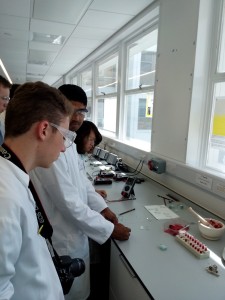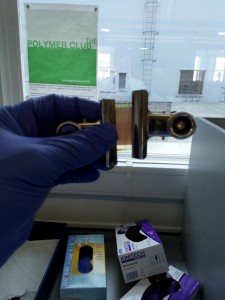We were off to Warwick University early after breakfast:

It was to be another two-hour journey to the university and nearly everyone in the bus fell asleep. The English countryside was just as beautiful as on the Stonehenge tip but not quite so special now:

The University of Warwick reminded me of TASC II at SFU where I work. We received goody bags with much recruitment materials for their graduate programs (not snacks):

After an intriguing lecture on electrochemistry principles and techniques, we were split into groups and given lab-grown carbon nanotube samples which we would analyze. My group headed off to the Scanning Electron Microscope (SEM) room where we first looked at a gold-coated fly’s eye and then searched for the nanotubes on our sample.

This powerful microscope scans a beam of electrons across the sample instead of the photons (light) used in optical microscopes. Since electrons with 5keV of energy have wavelengths in the sub-angstrom range [needs citation] the resolution is hundreds of times finer than photons can manage. Consequently biologists and physicists alike have become deeply dependent on the SEM to understand both the living cell and the transistor:

(SEM image of pollen grains ruthlessly taken from http://en.wikipedia.org/wiki/Scanning_electron_microscope#mediaviewer/File:Misc_pollen.jpg)
Although this was very interesting to me, it was not unlike what I’ve seen at work in my research position at SFU. When we failed to spot the nanotubes in the SEM, we made our way to the Atomic Force Microscope (AFM) room where they appeared almost instantly on the screen:

Unlike the SEM, AFM measures the strain felt by a cantilever that vibrates very nearly above the sample surface and generates a map indicative of its nano-scale topography. Like the Scanning Tunneling Microscope (STM) I use in research, AFM empowers us to observe individual atoms and molecules. As a result, the AFM image of our sample showed some clear worm-like structures: unmistakable tubes of carbon tens-of-thousands of times thinner than the human hair: 
http://www.phys-chemie.uni-wuerzburg.de/fileadmin/08050200/user_upload/STM_ball_stick.jpg Carbon nanotubes are elegant little structures that have delighted scientists with their plethora of applications from chemical filtration to artificial muscle fiber combined with intense strength and unique electrical properties. During our lunch break, I spoke to some of their PhD. students one of which had heard about my research group back at SFU – in collaborative research it’s a small world! I also met a Warwick post-doctoral student from Canada. After a scrumptious lunch, my group continued to the electrochemistry lab and suited up:

We were taught how to construct inexpensive natural dye-sensitised solar cells using glass slides, TiO2 nanoparticles, conductive glass, iodine ionic solution, and raspberry extract dye:

These fascinating creations displayed a definite sensitivity to light that generated up to 0.3V at a few-tenths of a milliamp – pretty impressive for such a simple design!

Scientists like the one here at Warwick are aiming to one day replace today’s exquisite silicon-based solar technology with these simple cells made of sustainable materials. Lastly, I got a recap of Red-ox chemical reactions I last saw in grade 12 and we used a three-electrode system to generate current vs. voltage plots of our carbon nanotube sample:
Overall, we learned a jolly good lump about electrochemistry and it’s applications from the real scientists in today’s field. This experience challenged me to rediscover my passion for chemistry – especially as it relates to physical systems. In the rest of the evening, many of the participants went to paid optional visits to see theatrical performances in London. I, however, hung out in the common room and worked on this very blog! Etienne


Ets, thank you for hanging out alone to write to all of us! Your Oupa Renier is also following your blog from South Africa!
As I was reading your accounts of this amazingly interesting day, one thing came to mind: “O LORD, how manifold are thy works! in wisdom hast thou made them all: the earth is full of thy riches.”
When I see these intricately small but perfect designs as you show above, and I walk out the back door, looking out at the heavens and see the intricate but unimaginably vast designs of our universe, I realize that perfect design spans from that very small to very vast realms and continue to take away our breath in wonder! Thanks for sharing Ets!! Wow!